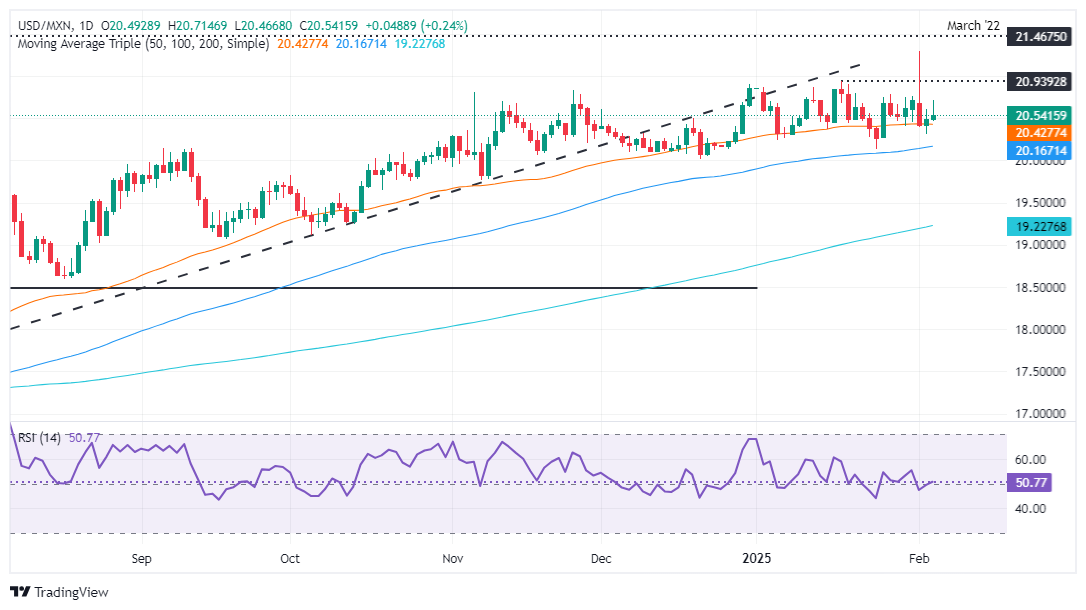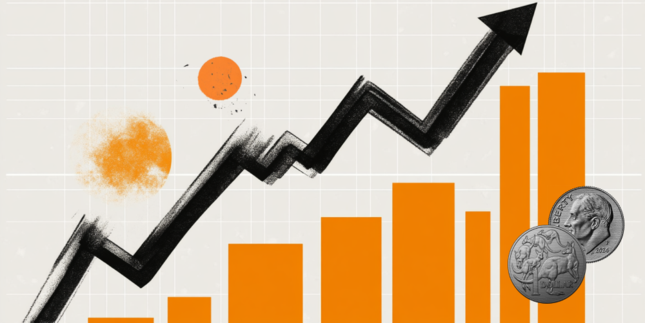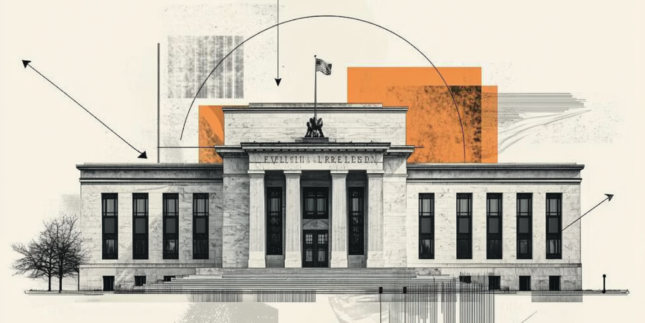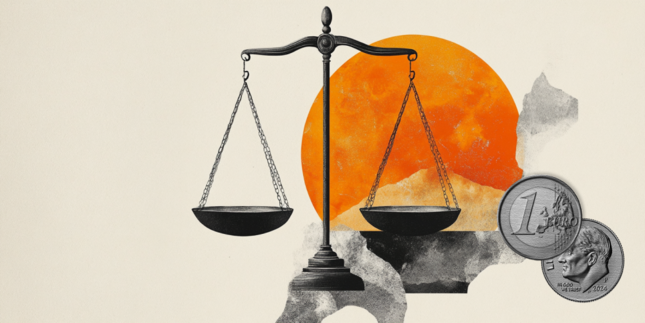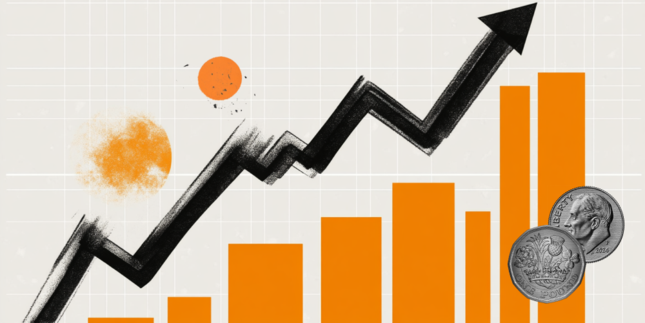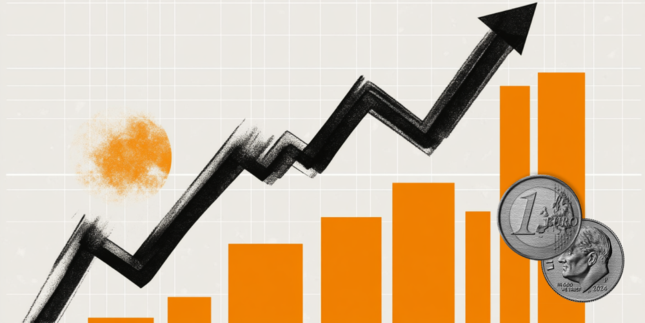Mexican Peso fails to benefit from soft USD and plunges
- The Mexican Peso depreciates as USD/MXN climbs above 20.50 as trade tensions between the US and Mexico ease.
- Mixed investment data and anticipated Banxico rate cut further pressure on the Mexican Peso.
- The White House clarifies trade measures with Mexico, focusing on anti-drug efforts.
The Mexican Peso (MXN) dropped for the second straight day versus the US Dollar (USD) as trade war fears began to fade. Upbeat United States (US) jobs data pressured the Mexican currency, which has failed to capitalize on broad US Dollar weakness. The USD/MXN trades at 20.57, up by 0.45%.
Mexico’s economic docket revealed mixed Gross Fixed Investment figures in November. The data underscores the ongoing economic slowdown and undermines the already battered Mexican Peso, which could weaken further as the Banco de Mexico (Banxico) is expected to lower interest rates by at least 25 basis points from 10% to 9.75% on Thursday.
Although trade disputes between the US and Mexico have found common ground, USD/MXN traders should know that there is a 30-day pause and that tensions could arise throughout the end of February. Peter Navarro, a trade adviser for the White House, said that Canada misunderstood that it is not a “trade war” but a drug war.
Therefore, tariffs on Mexico will remain paused if the Government improves on its fight against drug cartels.
In the US, data keeps the Greenback on the back foot. The Institute for Supply Management (ISM) revealed that business activity in the US services sector cooled down in January. Other data showed that the jobs market remains solid as traders prepare for the release of US Nonfarm Payrolls numbers on Friday.
Daily digest market movers: Mexican Peso remains heavy amid broad USD weakness
- Gross Fixed Investment in Mexico rose 0.1% MoM in November, down from 0.3% in October, but exceeded forecasts of -0.1%. On a yearly basis, it improved from -2.6% contraction to -0.7%.
- Mexico’s Business Confidence in January showed signs of improvement, though business activity contracted, according to S&P Global. The manufacturing sector contracted for the seventh straight month in January, indicating that the economy is slowing down
- Banxico’s private economists survey showed that Mexico’s economy is expected to grow by 1% in 2025, down from 1.2% in the December survey. Inflation is expected to tick higher from 3.80% to 3.83%, while core prices are foreseen at 3.74%, up from 3.72%.
- Economists estimate the USD/MXN pair exchange rate to finish the year at 20.90, up from 20.53 in December, and estimate 150 basis points of easing from Banxico.
- The US ADP National Employment Change in January grew from 176K to 183K, exceeding estimates of 150K.
- The ISM Services PMI, for the same period as the ADP, rose 52.9 and exceeded forecasts of 52.8 but dipped compared to December’s 54.0.
- S&P Global featured Services PMI for January, which dipped from 56.8 to 52.9, better than the 52.8 expected.
- Money market fed funds rate futures are pricing in 52 basis points (bps) of easing by the Federal Reserve in 2025.
USD/MXN technical outlook: Mexican Peso weakens past 20.50 as buyers target 20.90
USD/MXN rose 0.265, recovering from a weekly low of 20.30 on Monday. Nevertheless, buyers' inability to achieve a daily close below the 50-day Simple Moving Average (SMA) of 20.41 sponsored the buck’s recovery to the detriment of the Peso.
For a bullish resumption, buyers must clear the previous year-to-date (YTD) peak of 20.90, ahead of the 21.00 figure. Further upside lies above the current YTD peak of 21.29.
Conversely, if sellers push USD/MXN below 20.30, it could fall to the 100-day SMA at 20.15. ahead of the 20.00 figure.
Banxico FAQs
The Bank of Mexico, also known as Banxico, is the country’s central bank. Its mission is to preserve the value of Mexico’s currency, the Mexican Peso (MXN), and to set the monetary policy. To this end, its main objective is to maintain low and stable inflation within target levels – at or close to its target of 3%, the midpoint in a tolerance band of between 2% and 4%.
The main tool of the Banxico to guide monetary policy is by setting interest rates. When inflation is above target, the bank will attempt to tame it by raising rates, making it more expensive for households and businesses to borrow money and thus cooling the economy. Higher interest rates are generally positive for the Mexican Peso (MXN) as they lead to higher yields, making the country a more attractive place for investors. On the contrary, lower interest rates tend to weaken MXN. The rate differential with the USD, or how the Banxico is expected to set interest rates compared with the US Federal Reserve (Fed), is a key factor.
Banxico meets eight times a year, and its monetary policy is greatly influenced by decisions of the US Federal Reserve (Fed). Therefore, the central bank’s decision-making committee usually gathers a week after the Fed. In doing so, Banxico reacts and sometimes anticipates monetary policy measures set by the Federal Reserve. For example, after the Covid-19 pandemic, before the Fed raised rates, Banxico did it first in an attempt to diminish the chances of a substantial depreciation of the Mexican Peso (MXN) and to prevent capital outflows that could destabilize the country.
Forex News
Keep up with the financial markets, know what's happening and what is affecting the markets with our latest market updates. Analyze market movers, trends and build your trading strategies accordingly.

